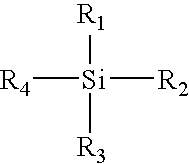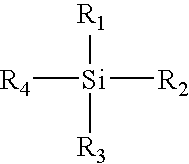Methods of refining silane compounds
a technology of silane compounds and silane, applied in the field of methods of refining silane compounds, can solve the problems of product contamination, disadvantageous known methods for reducing acidic halides, and negation of the usefulness and benefits of incorporating silane into sealants
- Summary
- Abstract
- Description
- Claims
- Application Information
AI Technical Summary
Problems solved by technology
Method used
Image
Examples
example 1
This example illustrates the production of vinyltriisopropenoxysilane according to the present invention.
A three-necked 1000 mL flask, equipped with a stirrer, thermometer, metal condenser, gas bubbler and nitrogen line is charged with 225.6 grams (3.88 moles, 6.5 eq.) of acetone under a slight nitrogen stream. Under nitrogen and stirring, 242.8 grams (2.4 moles, 4 eq.) of triethylamine and 1.2 grams (12 mmols, 2%) copper chloride (CuCl) are added. Upon observation, the mixture turns blue and then green. The mixture is heated to 40° C., then heating is removed. Via addition funnel, 96.8 grams (0.6 mols) of vinyltrichlorosilane are added over 15-25 minutes under nitrogen and with vigorous stirring and no additional heating so that a temperature of 50-60° C. is maintained. Upon observation, the mixture turns yellow and then brown. A triethylamine-HCl precipitate forms. The mixture is heated under nitrogen and with stirring to a reflux (59° C. pot temperature) for 18 hours. The prec...
example 2
A mixture of 65 moles of acetone, 40 moles of triethylamine, and 0.12 moles of copper chloride is introduced into a reaction vessel equipped with a nitrogen gas source. Nitrogen is introduced into the vessel to create a nitrogen blanket at approximately ambient pressure. The mixture is stirred and maintained at approximately 60° C. Into this mixture is added 6 moles of vinyltrichlorosilane. As the reaction progresses and vinyltriisopropenoxysilane produced, the acidic halide triethylamine-HCl precipitate forms. After the reaction is substantially complete, the product is filtered to remove most of the solid triethylamine-HCl from the mixture.
The remaining filtrate is transferred into another vessel and heated to approximately 60-70° C. Sampling of the filtrate indicates that approximately 0.9 moles of triethylamine-HCl are present. Approximately 0.9 moles of sodium phthalimide is added to the filtrate. After 5 minutes, the solution is distilled. The silane product after distillat...
example 3
A method similar to the one described in Example 2 is performed, except that acidic halide is neutralized by potassium-1,1,1,3,3,3-hexymethyldisilazane.
PUM
| Property | Measurement | Unit |
|---|---|---|
| concentration | aaaaa | aaaaa |
| hydrolyzable | aaaaa | aaaaa |
| weight | aaaaa | aaaaa |
Abstract
Description
Claims
Application Information
 Login to View More
Login to View More - R&D
- Intellectual Property
- Life Sciences
- Materials
- Tech Scout
- Unparalleled Data Quality
- Higher Quality Content
- 60% Fewer Hallucinations
Browse by: Latest US Patents, China's latest patents, Technical Efficacy Thesaurus, Application Domain, Technology Topic, Popular Technical Reports.
© 2025 PatSnap. All rights reserved.Legal|Privacy policy|Modern Slavery Act Transparency Statement|Sitemap|About US| Contact US: help@patsnap.com


